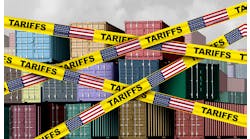| Global Logistics Trading Blocks |
The typical consumer product is handled by as many as 12 different organizations before it reaches the end user. While portions of this supply chain provide valuable services, the majority only add costs and delays for the shipper. The challenge for the shipper, of course, is to identify and then streamline those costs/delay points.
Despite the fact that the Internet enables the high-speed exchange of information and ideas, international trade processes — repeated daily around the world — are still based on horse-and-buggy technology, says Frank Cirimele, vice president of global trade at XPORTA Inc., a provider of global sourcing solutions. Industry groups like RosettaNet and trade facilitation organizations like the World Trade Organization (WTO) have recognized this weakness, and are dedicating significant resources to standardizing and automating global trade. However, at this point in time, the processes for importing and exporting remain convoluted and, in many cases, border on the arcane.
At the same time, many companies still rely on outdated manual processes and paperwork for international business, according to Neetin Datar, director of trade and compliance applications for enterprise software giant SAP. “This whole area has been neglected by companies,” Datar says. “It’s amazing to walk into a multibillion-dollar company and, when we talk with them, they say they’re doing all this manually. Global trade is an afterthought for them.”
Within this environment, what should an importer or exporter know about global trade processes? How can a shipper get smarter and avoid making mistakes that not only slow down the flow of goods but potentially carry significant cost penalties?
To answer those questions, this article will focus on the basic requirements of the two key parties involved — the seller/exporter and the buyer/importer.
The seller of the goods is responsible for the quality, quantity and ship date of the goods agreed upon. The seller is also responsible for complying with all applicable Export Regulations regarding the shipping of its goods.
“Keep in mind that exporting is a privilege, not a right, and the privilege to export can be denied to any firm and/or person who violates applicable export regulations,” says Cirimele, who represents the U.S. on the United Nations International Trade Procedures working group.
For the U.S., the “exporter of record” is responsible for complying with all export regulations. This includes:
• Determining licensing authority (license, license exception, or NLR — no license required)
• Not selling to parties on the “Restricted/Prohibited Parties” list
• Following anti-boycott guidelines
• Applying acceptable “Diversion Risk Screening”
• Following “Nuclear, Missile, and Chemical & Biological Weapon Screening.”
Exporters usually address export compliance responsibilities in one of two ways, Cirimele notes. They hire, train and maintain an in-house staff of experts to set up, update and maintain an internal export compliance program. Or, they outsource this function to a third party, usually a freight forwarder or logistics provider.
Export documentation
The seller/exporter is responsible for all export documentation. According to Cirimele, this includes submitting appropriate transactional information via an export declaration, which must include a Schedule B number in the U.S. and a Harmonized Schedule number in other countries. The export declaration — also known as an shipper’s export declaration — is submitted manually or electronically upon export.
Other required documents that accompany the goods to the destination include:
• a commercial invoice
• packing slip
• air waybill or shipper’s letter of instruction.
In addition, the exporter may generate other documents needed by the buyer to facilitate the import clearance process at destination, i.e., certificate of origin, inspection certificate, consular invoice, and so on. Supplemental documents may be needed to fulfill the agreed upon payment terms, i.e., letter of credit, sight drafts, and so on.
Carriers
Carriers provide documentation services to assist exporters in meeting the obvious documentary requirements of global trade, usually at additional cost. The carrier systems are designed to “hold,” or delay, any shipments identified to be missing documents, or incomplete information. According to Cirimele, “These delays and manual interventions increase the transit time to the buyer, and add costs to the transaction.”
While the exporter may authorize the carrier to generate documents, or complete certain data fields, the exporter retains ultimate responsibility and liability for the accuracy of these documents.
Customs brokers
When a shipment arrives in its destination country, the carrier turns the specific document packets over to the customs broker — an individual or firm licensed to submit documents to local customs for customs clearance purposes. The transportation carrier either has an in-house customs broker or a designated agent to perform this function, and the buyer may have his own customs broker.
In a traditional situation, notes Cirimele, the customs broker reviews the document packet to ensure that all necessary information is included. This includes classifying each item according to the Harmonized Schedule number (HS) assigned by the importing country’s customs tariff.
“While the ten-digit HS number is similar for most countries, per the World Trade Organization (WTO) agreement, only the first six digits are standardized,” Cirimele notes. “The remaining four digits are left for individual countries to assign. Applying the correct destination-country HS number is critical because it determines the appropriate duty rate for that particular item arriving into that country.”
At this time, the applicable VAT (value-added tax) or GST (general sales tax) is assigned based on the type of goods and other above factors. Any other appropriate taxes or fees will be calculated and included with the customs forms.
Once the classification process is completed, the customs broker checks to see if the goods listed on the documents comply with all country-specific import regulations. These regulations can include quotas, anti-dumping, markings, content, country of origin and special agency requirements (e.g., food and health).
The customs clearance process can also be initiated by a pre-clearance customs filing, based on fax copies of documents, or for ocean shipments, a couriered set of original documents.
“Some countries allow this information to be used for the basis of submitting a customs entry prior to the actual goods arriving,” Cirimele points out. “With an ocean freight shipment, an entry can be submitted 24 hours prior to the actual vessel arrival, while for an air freight shipment, it is done on a ‘wheels up’ basis, meaning the aircraft has departed the origin and is in the air to the destination airport of entry.”
The customs broker is now ready to submit the documents to customs, and can do so either manually or electronically, depending on the importing country’s requirements. In a manual environment, the customs broker completes all the local customs forms using the data from the arrival documents. It then attaches copies of any required documents (i.e., the commercial invoice, packing slip, etc.) to the local customs form and physically delivers this entry packet to the local port customs office.
Customs, Cirimele notes, reviews the documents and usually does one of three things:
1. Stamps the documents as “cleared” and places them in some form of out basket for the broker to retrieve.
2. Notifies the customs broker that additional documents are needed and must be reviewed.
3. Notifies the customs broker that a physical examination of the goods is required.
The method of payment for settlement of duty, BAT/GST, excise tax and other charges are included in the entry information. These fees must be settled prior to Customs releasing the goods; payment can either accompany the entry packet, or be debited to a pre-arranged account of the customs broker or buyer.
“In countries that support an electronic environment, instead of typing the actual customs forms, the customs broker will usually enter the same data elements into a proprietary customs system and submit the form electronically,” Cirimele notes. “Once customs receives the data, it follows the same three steps as outlined in the manual environment, but with automated notification back to the customs broker. While some countries support this form of electronic submission of data, they also require that a complete document packet be submitted within 24 hours of clearance.”
Just as the exporter bears the responsibility for complying with all export regulations, the buyer — or importer of record — is accountable for properly observing all import regulations.
“The key thing to keep in mind is that the importer is ultimately responsible for making correct declarations to Customs or any other agency that oversees trade,” says Norman Schenk, vice president of brokerage services for UPS Trade Management Services. “Even though you as the importer may use brokers that do a lot of the work, you must maintain oversight of the compliance piece. You must stay actively involved because you are ultimately liable for compliance.”
For this reason, good record-keeping is critical. “No matter what you do,” Schenk emphasizes, “you should be careful to maintain accurate, up-to-date shipping documents, commercial invoices, and any other clearance forms. Basically, you have to keep any document relevant to the process. When Customs goes through its processes to determine what types of shipments to inspect on its periodic blitzes, a lot of its decision is based on the quality of the records maintained by a company.”
One of the key tenets of U.S. import compliance lies in the “reasonable care” doctrine. As part of the Customs Modernization Act (which took effect a decade ago), legislators established the requirement that the importer of record use reasonable care by filing with Customs the declared value, classification and rate of duty and such other documentation or information as is necessary to enable Customs to properly assess duties, collect accurate statistics and determine whether any other legal requirements are met.
In essence, the Customs Modernization Act “shifts the burden of responsibility for compliance onto the importer,” says Darren Maynard, chief operating officer of NextLinx Corp., a provider of global trade management solutions. “In the act, Customs basically said, ‘It’s not our job to make sure you’re doing it right. You have to do it right, and we will audit you to make sure.’”
In many companies, top management has difficulty seeing the return on investment in an import/export compliance program. That attitude is shortsighted and ill-advised, suggests Schenk.
“I strongly believe that a good compliance program will bring a good return on investment,” he says. “We encourage companies that simply consider these efforts as a cost center to consider the costs of border delays, or a full-scale audit by customs. Customs can spend anywhere from one to six months auditing your records and be totally disruptive while doing it. You end up spending more on the audit than if you’d put the thing in line in the first place.”
Maynard agrees. “Once Customs thinks you’re not doing a good job, they’ll start hanging around for not just one month, but many months at a time. If they see that you have a poor track record regarding documentation, and you don’t have your systems all linked up, they can ask you to pull all your payables and your warehouse receipts, and match them all up — going back months.”
A lot of companies make the mistake of thinking it’s the customs broker’s job to handle and maintain the paperwork, Maynard cautions, but that’s not the case at all. “Customs requires you to maintain all relevant records,” he says.
Being on Customs’ “good company” list has other benefits as well, Schenk reports. “Generally, when you clear a shipment through customs, you have 10 days in which to pay your duties. If you participate in C-TPAT (the Customs-Trade Partnership Against Terrorism security initiative), you are eligible for the summary payment program, which gives you 45 days to pay duties. For some big companies, the float alone makes a stepped-up compliance program worthwhile.”
Feedback on this article?
© Want to use this article?
Click here for options!
Copyright© 2003 Penton Media, Inc.


